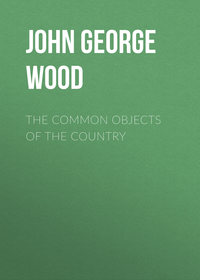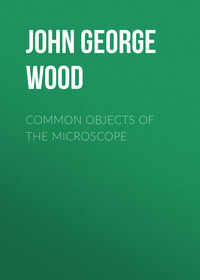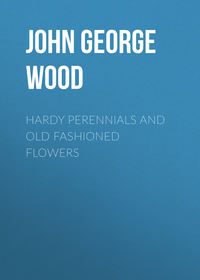
Nature's Teachings
The illustration represents the pupa of the common Swallow-tailed Butterfly, while in the centre is the same insect in the perfect state as it appears when resting. It really seems as if the ancient habit of the pupa had been remembered by the perfect insect, the long ends of the hinder wings taking the place of the pupal tail, and the legs that of the belt.
The WheelYet another aid to locomotion is found in the Wheel, a contrivance for diminishing friction.
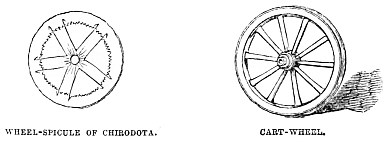
When man first learnt that heavier weights could be dragged than carried, he simply placed them on flat boards to which ropes were attached. The next step was necessarily the invention of the sledge, the burden resting on two parallel runners, the ends of which were slightly curved so as to prevent them from hitching against any small obstruction. In some countries—such, for example, as in Esquimaux-land—the sledge is the only vehicle practicable, and even Europeans, when they visit that country, are fain to adopt the sledge if they would live.
But, in more temperate zones, the Wheel is paramount. In its earlier stages the wheel was a very simple business. It was simply a section of, a tree-trunk, dubbed roughly round, and with a hole in the centre, through which the axle passed. Such wheels are still in existence in many parts of Europe; and, owing to the want of regularity of outline in the circumference, and the utter absence of grease, the wheels keep up a continuous shriek, almost deafening to those who are unused to it, but perfectly unheeded by those who own or drive the vehicle.
The next improvement was to make the circumference of the wheel as perfectly circular as the art of man could devise, and, instead of having the wheel solid, to fill up its interior with spokes, thus gaining lightness and strength at the same time.
Of all locomotive wheels, I suppose that the modern Bicycle affords the best example. The driving wheel is larger than the hind wheel of an ordinary coach, and yet the spokes are not nearly so thick as the porcupine quill with which this account is written.
If we look at the ancient sculptures and paintings of Egypt and Assyria, as preserved in the British Museum, we shall see that either kind of wheel was used according to the work which it had to do. The solid, uneven, squeaking, wooden wheel was devoted to agriculture, while the light, spoked wheel was sacred either to warfare or hunting.
Let us hope that in the two latter cases some modicum of grease might have been used, as the outcries of tortured and unlubricated machinery are enough to drive away all wild beasts which come within the range of its complaints, while the nervous system of hunter or warrior must have been seriously damaged by it.
Even in such a structure as the spoked Wheel, Nature has anticipated Man.
My readers may remember that, when treating of nautical matters, I mentioned the singular anchor-shaped spicules that are found upon one of the sea-slugs, called Synapta.
There is another group of these creatures inhabiting the Mediterranean, in which the skin-spicules take a different form. Like those of the Synapta, they are too small and translucent to be seen without the aid of the microscope and carefully adjusted light. But, just as the spicules of the Synapta resemble the ancient anchor, so do those of the Chirodota resemble the ancient wheel, the similitude being in both cases absolutely startling.
Not only that, but, as all readers must be aware, if they have studied practical mechanics, there are many machines which are toothed on the inner, and not the outer, side of the circumference. Here, in the Chirodota, the inner toothing is manifest.
What purpose it serves we know not. The Chirodota’s wheels (of which there are thousands) never revolve, neither do the anchors of the Synapta hold the ground. Yet the very fact that such exceedingly minute objects should be so carefully constructed tells us at once that they must have some important purpose to serve, though at present that purpose is a mystery which no one has attempted to solve.
I have little doubt that when the hour and the man arrive, as arrive they surely will, we shall find in these tiny and almost unrecognised spicules the keys to treasures of wisdom which at present have been opened to no human being.
The whole history of the progress of the human race shows that facts have been allowed to accumulate, fought about, and turned in all directions, before the generaliser comes who pierces to the heart of everything, reduces apparent discrepancies to harmony, and usually is rewarded by finding some one else assume the credit of his discoveries, and receive all the honours and emoluments.
CHAPTER XIV
Paper and its many Uses.—The Egyptian Papyrus.—India Paper.—China and its Manufactories.—Materials of which Paper is made.—Annual Consumption of Material.—The “Water Mark.”—Nature’s Papers.—Wasps and Hornets.—The common Wasp, and the various Materials of its Nest.—Utilisation of Material.—Papier-mâché.—Printing.—Nature-printing.—Method and Results of the Process.—Use of the Electrotype.—“Facing” the Copper Plates with hard Metal.—The Coal Mine and its Nature-printing.—Stippling, its Use and Abuse.—The Line and the Dot.—Modification of the Dot.—Flower-petals.—The Pelargonium.—Plaster Castings.—Stereotyping and Electrotyping.—Modern Method of taking Plaster Casts.—The Principle of Corrugation.—Flower-pot Covers.—Iron Buildings.—The Polistes and its Corrugated Dwellings.
ArtWE will now touch lightly on the subject of Art.
In the present day one of the most indispensable accessories to art is Paper.
It is a curious fact that we have no records as to the time when paper was first invented. The Egyptian papyrus we do not consider, as it was not paper in our sense of the word, although we have retained the name.
Paper is a vegetable fibre carefully disintegrated, made into a pulp with water, and then dried in thin sheets. As is the case with many arts, China seems to have taken the lead in paper manufacture, and we are even now indebted to that country for the “India Paper” on which the finest proofs of engravings are taken. This paper is made from the inner bark of the bamboo. “Rice Paper,” so called, is not paper at all, but only a kind of pith cut spirally, and flattened by pressure.
There is scarcely any vegetable fibre of which paper cannot be made, and various plants have been suggested for this purpose, such as the stinging-nettle, cabbage-stalks, hop-bines, the waste of sugar-cane, sawdust, &c. Straw has already been successfully used, and so has Esparto grass.
Some years ago, when there was a scarcity of material for paper-making, the well-known Grass-wrack of our shores (Zostera marina) was brought into partial use. I believe, however, that the experiment was not a successful one. The Chinese make their paper of bamboo, macerating and pounding it until it is reduced to a pulp, and then shaken into fibres in a mould.
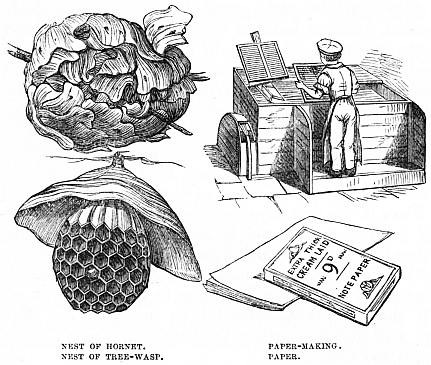
With us, white paper, such as is used by the writer, printer, or artist, is made almost exclusively of cotton or linen rags. Upwards of a hundred and twenty thousand tons weight of rags are annually consumed in this country for the manufacture of paper. After being bleached, they are torn and ground into a pulp, which is then handed over to the actual maker.
The illustration represents paper-making by hand, a process which is now rarely used, except for special kinds of paper. Omitting technical details, the mode of paper-making by hand is as follows:—The pulp being prepared, the workman takes a “mould,” i.e. a frame with a bottom of closely woven wire. Having put into the mould a sufficient quantity of pulp, he shakes the mould so as to spread the pulp evenly over the surface. The water runs away between the wires, the sheet of pulp is transferred to a piece of felt, and when it is dry it becomes paper. If a sheet of ordinary note-paper be held up to the light, the marks of the wires are plainly perceptible. The so-called “water-mark” is due to wires twisted into the requisite shape.
The Chinese workman makes his paper exactly on the same principle, but the bottom of his mould is made of bulrushes instead of wires.
As for machine-made paper, the process seems absolutely magical. Endless bands of felt and wire are substituted for the hand frames, and, the pulp being poured in at one end, the finished paper is poured out at the other, and self-wound on rollers. Without any exaggeration, paper is now made by the mile, the only limit to its length being the size of the rolls.
When I mention Paper-making in the world of Nature, many of my readers will at once know that I am about to refer to the Wasp tribe.
These insects were paper-makers long before even the Chinese had invented the art, and, so exactly similar is the mode of action, that man might well have copied from the insect.
The Wasp gnaws a bundle of vegetable fibres, mostly of wood, sound or decaying, according to the species. It masticates them until it has reduced them to a pulp, and then, by means of its jaws, spreads the pulp into sheets of various shapes and sizes.
With some of the pulp it forms hexagonal cells like those of the bee, and with some it makes the roof-like covering which defends the cells. Not only that, but it can make a sort of papier-mâché, which it uses for the flooring, if we may so call it, of the different strata of cells, and for the pillars which bind them together.
Like our own paper manufacturers, it is economic of material, will re-masticate any superabundant paper, and is only too glad if it can get hold of any paper made by man. I have seen a wasps’ nest which was made entirely from the empty blue and white cartridges that were thrown away by soldiers.
Then there is as much difference in the papers made by wasps as in those made by man. In this country all wasps’ nests are made of very fragile material, but in South America there are some wasps which make the external covering of their nests as hard and white as the stiff cardboard employed by artists.
Having now got our paper, we will glance at one or two modes of using it for Art. Papier-mâché has already been mentioned, and it is worthy of notice that there are now in existence many decorated ceilings which are made of this material, on account of its great strength and its non-liability to fire.

The first invention which we shall notice is that which is known by the name of Nature-printing, and which has been so successful in transferring to paper an exact representation of vegetable foliage.
One simple tolerably efficacious mode of Nature-printing has long been known. A piece of paper being rubbed with lamp-black and oil, the leaf was laid upon it and gently rubbed, so as to transfer the lamp-black to the nervures. It was then laid on a sheet of white paper, and again rubbed, when an impression of the leaf was left upon the paper.
The present system of Nature-printing is far in advance of this rather rude method, and amounts to an exact reproduction of the plant, not only in form and detail, but in colour.
In order to illustrate this beautiful process, I cannot do better than transfer to these pages the following account of Nature-printing as given in Ure’s “Dictionary of Arts,” &c. It is an abstract of a lecture delivered by Mr. H. Bradbury at the Royal Institution.
“Nature-printing is the name given to a technical process for obtaining printed reproductions of plants and other objects upon paper, in a manner so truthful, that only a close inspection reveals the fact of their being copies; and so distinctly sensible even to touch are the impressions, that it is difficult to persuade those unacquainted with the manipulation that they are an emanation of the printing-press.
“The distinguishing feature of the process consists, first, in impressing natural objects—such as plants, mosses, seaweeds, and feathers—into plates of metal, causing, as it were, the objects to engrave themselves by pressure; secondly, in being able to take such casts or copies of the impressed plates as can be printed from at the ordinary copper-plate press.
“This secures, in the case of a plant, on the one hand, a perfect representation of its characteristic outline, of some of the other external marks by which it is known, and even in some measure of its structure, as in the venation of ferns and the ribs of the leaves of flowering plants; and, on the other, affords the means of multiplying copies in a quick and easy manner, at a trifling expense compared with the result, and to an unlimited extent.
“The great defect of all pictorial representations of botanical figures has consisted in the inability of art to represent faithfully those minute peculiarities by which natural objects are often best distinguished. Nature-printing has therefore come to the aid of this branch of science in particular, whilst its future development promises facilities for copying other objects of nature, the reproduction of which is not within the province of the human hand to execute; and even if it were possible, it would involve an amount of labour scarcely commensurate with the results.
“Possessing the advantages of rapid and economic production, the means of unlimited multiplication, and, above all, unsurpassable resemblance to the original, nature-printing is calculated to assist much in facilitating not only the first-sight recognition of many objects in natural history, but in supplying the detailed evidences of identification, which must prove of essential value to botanical science in particular.”
Many plans have been tried with only partial success, but that which is now in operation produces the most wonderful results. The plants are laid upon sheets of lead, and then passed through rollers, so as to leave an impression in the soft metal. The electrotype then comes into play, exact copies of the impression being taken by it. As the face of the electrotyped plate is covered with a slight deposit of some hard metal, usually nickel, a great number of copies can be taken without damaging the plate.
A wonderfully exact parallel to Nature-printing is seen in almost every coal bed. In the coal are found impressions of various leaves, mostly ferns, and so exact are they, that the different species have been determined and named with as much accuracy as if, instead of mere impressions, they had been the fern-leaves themselves.
Indeed, if it were needed, it would be perfectly easy to take electrotype plates from these impressions, and to treat them in exactly the same manner as those obtained in the way which has already been described.
StipplingWe now come to another branch of Art, namely, the production of shadow in an engraving by means of Stippling, i.e. the insertion of dots instead of lines. At one time the Stipple was in great favour. Then it was almost wholly abandoned in favour of the line, and now it is much used in conjunction with the line, especially for the delicate shading of flesh tints, such as faces, female arms, &c.
In the illustration a little stippling of a cheek is shown, the dots being purposely exaggerated.
A singularly beautiful modification of the Stipple is now in use. When the engraver wishes for exceptional softness of shading, he does not content himself with mere dots, but, with the aid of his magnifying-glass, converts each dot into a tiny star with three or more rays. Thus the dots seem to melt into each other, and the requisite softness is obtained.
A very good example of this star-stipple is seen in the well-known print called “Coming of Age.” If the face and neck of the girl in the foreground be examined with a magnifying-glass, the apparent dots will be seen to be stars, so beautifully arranged that the projecting rays of one fuse themselves, so to speak, with, those of the surrounding stars, as is shown in the illustration.
Whether the engraver who hit upon this singularly effective plan took it from Nature, I cannot say, but he well might have done so, had he examined the petal of a flower through a good microscope. We all know the peculiar rich softness of a petal, and how our very best floral artists feel the impossibility of transferring it to paper.
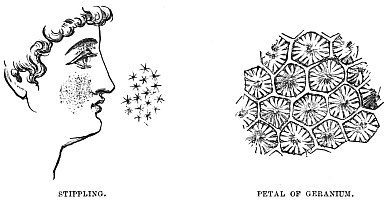
The real reason for this special beauty lies in the star-stippling of the petal. The whole surface of the petal is covered with multitudinous projections, which are, in fact, undeveloped hairs. These projections are wrinkled down the sides, and so, when viewed from above, they present the curious star-like appearance shown on the right hand of the illustration.
The drawing is taken from a petal of Pelargonium prepared by myself.
There is yet one point in the petal which the star-stipple has not touched, and probably cannot touch. I mean the slight projection of the stipple-hairs, which give an effect of light and shade as well as mere flat softness.
Plaster CastsWe have already mentioned the electrotype, and may now come to a branch of art which is much associated with it, namely, the Stereotype.
As many of my readers may know, types are very valuable articles, and must not be wasted. If, therefore, a book should be thought likely to have a steady sale, much of its value would be lost if the types were kept standing, inasmuch as they could not be used for any other work.
In such cases the Stereotype is employed. Omitting minute details, the process is as follows:—
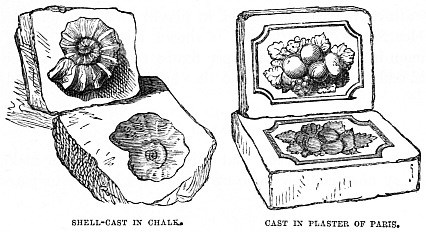
The type, ready set up, is carefully oiled. Plaster of Paris mixed with water is then poured into a shallow trough, and the type pressed into it. In a short time the plaster hardens, and the type is withdrawn. The plaster mould is then baked, to drive off all moisture, and type metal is poured into it. Thus a solid mass is procured, instead of a number of separate pieces, so that there is no danger of disturbance, and the whole block can be multiplied ad libitum if needed. This process sets free the types, which can be broken up and used again.
The ordinary method of taking plaster casts is nearly the same as that which has been described. The object to be cast is oiled, and plaster of Paris carefully applied to it. When it is “set,” the plaster “mould” is removed and dried. The process is then reversed, the interior of the mould being oiled, and plaster poured into it, so as to produce an exact reproduction of the original.
In Nature we have almost exactly the same process, although it is necessarily conducted in a much slower manner.
All who have tried their hand at practical geology must be aware of the multitudinous casts of perished beings which are found in various strata. Sometimes the casts are those of vegetables, the original material having been decomposed, and stony matter taken its place. Sometimes there are casts of fishes or echini, while shells, and even insects, are found to have been cast almost as perfectly as could be done with plaster of Paris at the present day.
As might be anticipated, the chalk deposits are peculiarly rich in these casts, the fine particles of the chalk taking the place of the plaster of Paris.
In the illustrations are shown examples of casting in Art and Nature. On the right hand is a cast of fruit and leaves, which may afterwards be reproduced in plaster, wax, papier-mâché, or electrotype. On the left is shown one of the shells so common in the chalk, the upper figure representing the shell itself, and the lower the mould that has been formed around it.
Corrugated IronWe have already seen that the Wasps are paper-makers. We may now see how some of the Wasps have anticipated a valuable invention of man, namely, the principle of corrugation, whereby a thin plate gains strength.
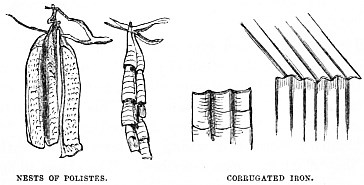
Even a sheet of paper gains great strength by corrugation, as is seen in those paper covers which are so much in use for the decoration, or rather the concealment, of flower-pots. But the best example that can be given of this principle is the Corrugated Iron, which has come so much into use for temporary buildings, such as schools, places of worship, reading-rooms, &c. It is very light and very strong, and can be used either for roof or walls with equal success.
By means of certain wasps belonging to the genus Polistes, Nature produces corrugated dwellings, which are made of very thin materials, but which are marvellously strong in proportion to their weight.
The insects belonging to this genus are all exotic, but are spread over a very large surface of the earth.
So strong are the nests made by some of these species, that they need no external covering, the corrugated paper supplying at the same time strength and warmth, the latter element being furnished by the air which is entangled between the corrugations.
There are many species of Polistes, mostly belonging to Australasia and tropical America, the latter displaying the greatest variety of form and structure in the nest.
CHAPTER XV
Electricity, Magnetism, and Galvanism mutually convertible.—The Force co-extensive with Nature.—Uses of Thunder-storms.—Languor from Want of Electricity.—Frictional and Voltaic Electricity.—Origin of the Name.—Structure of the Voltaic Pile.—A simple Example of the Pile.—Nerves of a Frog’s Leg.—The Electric Shock, and how to produce it.—The Electric Jar and Battery.—Animal Electricity.—The Torpedo and Electric Eel.—Structure of the Electric Apparatus.—The Electric Spark obtained from both Fishes.—Channels of Electricity in the Body.—The Will and the Muscles.—Electricity the conducting Agent.—The Human Body permeated by Nerves.—Telegraph Wires and the Nervous System.—Lightning and the Electric Spark.—The Electric Light and its Power.—The Fire-fly, the Glow-worm, and the luminous Inhabitants of the Sea.—Magnetism and Diamagnetism.—The Electric Telegraph and the Compass.—The Principle identical in both Instruments.
Electricity and MagnetismIT has long been known that Electricity, Galvanism, and Magnetism are but different manifestations of the same force, and that one can be converted into the other at will. It is also known that this wonderful and most important principle lies latent in everything, and only needs the proper machinery to evoke it.
The few following illustrations are intended to show its prevalence in Nature, and that human art does not create, but only makes manifest a power that exists, but lies latent until called forth.
Without going into details, which would occupy the whole of such a volume as this, I may mention that Electricity saturates all the material creation, and that even man himself is not only a reservoir of electricity, but that he feels positively ill if the normal amount be not supplied.
Take, for example, the hours that precede a thunder-storm. We feel languid and depressed. We cannot bring our thoughts together. We are almost incapable even of bodily labour. The reason is, that the portion of the earth on which we live has parted with some of its electricity, and has drawn it out of our bodies.
Then comes the welcome thunder-storm; clouds overcharged with electricity come to restore the balance. The lightning flashes from the clouds to the earth as soon as they are near enough; the rain falls, carrying with it stores of silent electricity; and in an hour or two all seems changed.
The air, which hitherto seemed to afford no nourishment to the lungs, is bracing and invigorating. The nervous system recovers its tension, and the brain can act without a painful effect. All Nature seems to put on a different aspect, and brightness and vigour take the place of dulness and languor.

By a strange coincidence, there is just such a lack of electricity as I am writing, and the barometer has rapidly sunk to such a degree that a storm seems inevitable.




